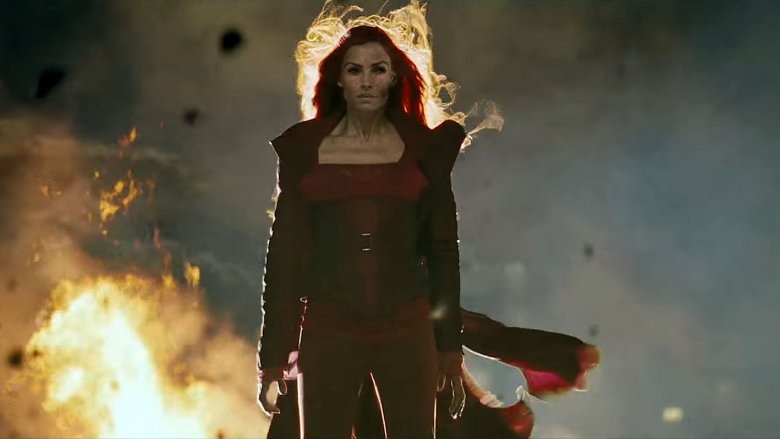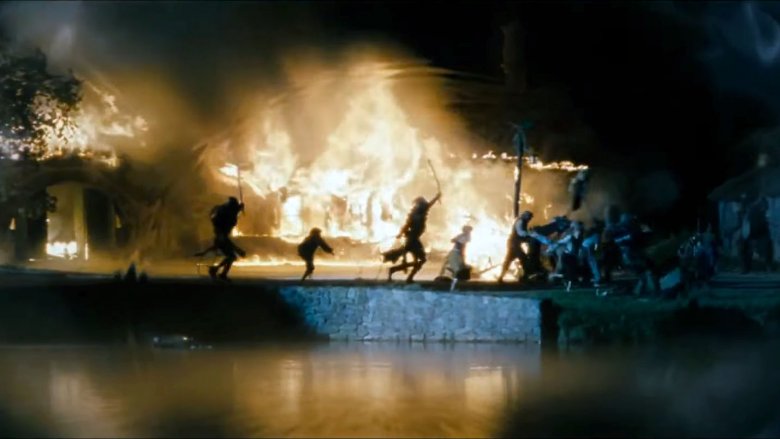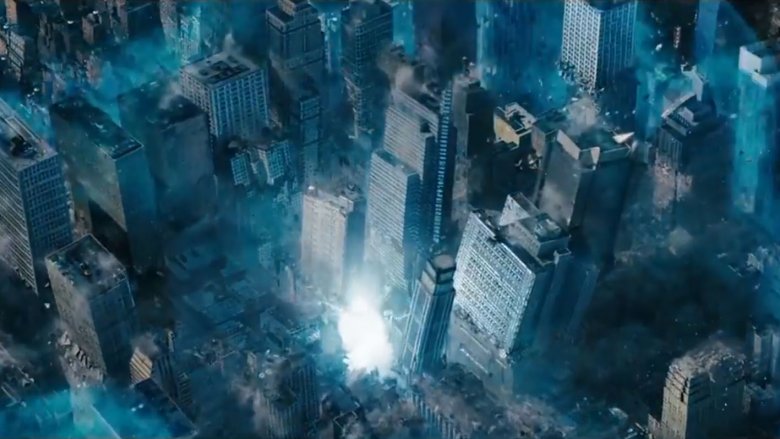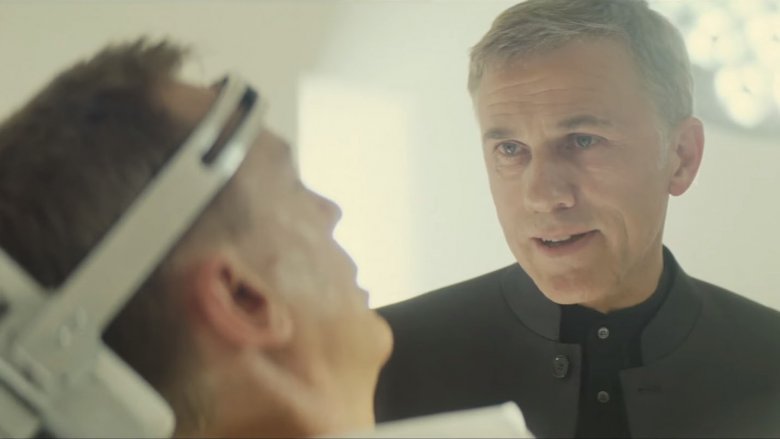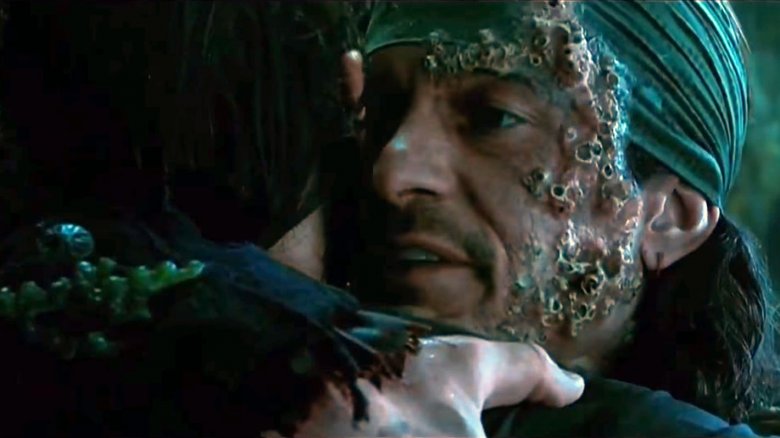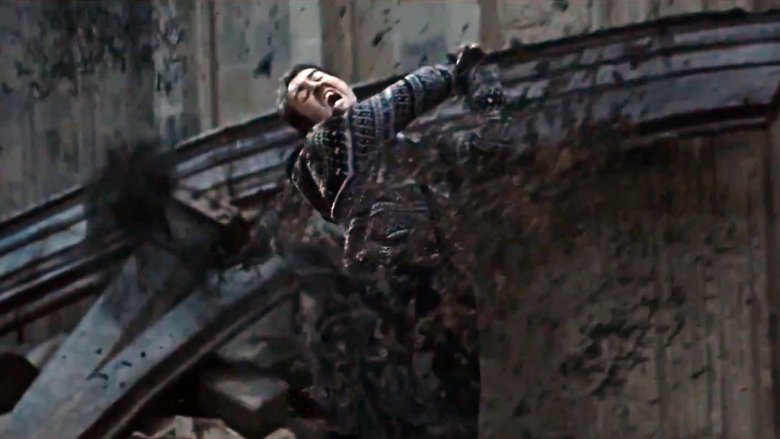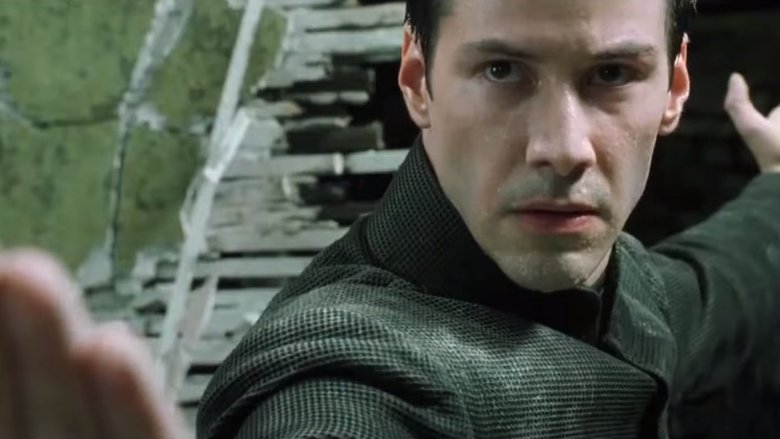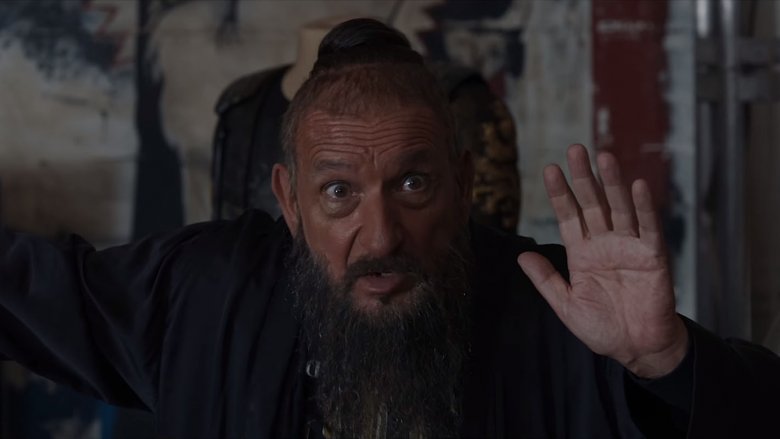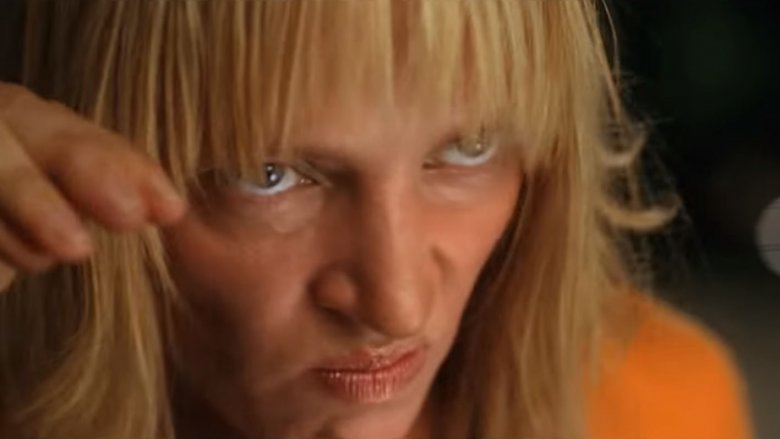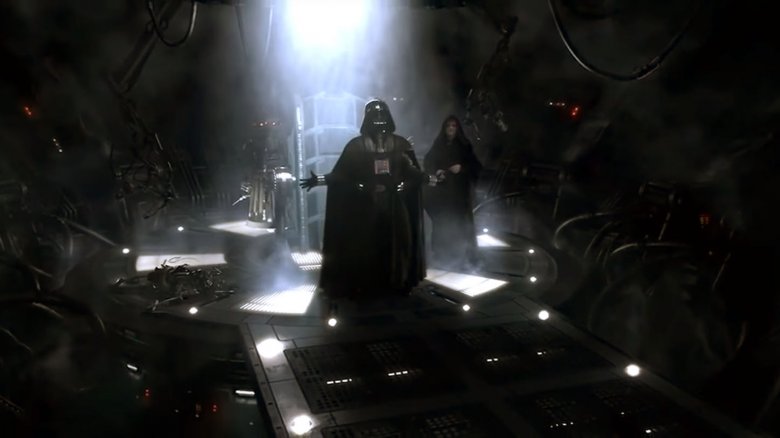Movie Moments That Hollywood Failed To Deliver To Fans
When you're a fan, you get used to disappointment. After all, Hollywood can't deliver the goods all the time. Sure, Infinity War was pretty great, but we've still got Justice League to deal with. Hunger Games might've torn it up at the box office, but Divergent couldn't quite make it to the finish line. Jurassic Park defined blockbuster cinema for a generation. Jurassic Park 2: The Lost World? Eh, not so much.
That's how it's been forever, and yet it still stings when a film fails to meet our expectations, especially when that means bungling a scene that we've waited years — sometimes decades — to see unfold on the big screen. Fans couldn't wait to see the following moments brought to life in the cinema, but when they arrived, the audience was less than thrilled. They should've been triumphs; instead, they're some of the most frustrating moments in movie history. Here's a not-so-fond look back at movie moments that Hollywood failed to deliver.
The Phoenix rises, but we wish she hadn't
When Jean Grey gave her life at the end of X2: X-Men United, sacrificing her life to save her teammates, X-fans knew what was coming, and they couldn't wait. After all, "The Dark Phoenix Saga" is considered one of the best X-Men storylines of all time. It's got everything an avid follower of Marvel's merry mutants could ever want: pulse-pounding action, epic melodrama, and an unforgettable ending.
Fox and Brett Ratner didn't get the memo. In the comics, when Jean Grey kills herself in order to keep the universe safe from the Dark Phoenix's power, it's both sad and unbearably right. Throughout the "Dark Phoenix Saga," we've watched as Jean is used like a puppet by both Mesmero and the Phoenix Force. Suicide is the only way for Jean to reassume control of her life, even if that means ending it. It's just as heartbreaking as it sounds.
In X-Men: The Last Stand, that's not how things go. At all. Instead of having Cyclops as an emotional anchor, Jean kills him — offscreen, even — when the action is just getting started. In the comics, the Dark Phoenix destroys a planet. In The Last Stand, she stands around looking moody. When she dies, it's Wolverine who does the deed, not Jean herself, robbing the former Marvel Girl of both her agency and her most heroic moment. It's not a tragically inevitable ending. It's a huge waste of, well, everything. No wonder Fox is going to try to do it again. They whiffed the first time around.
A Shire left unscoured
In the books, The Lord of the Rings doesn't end with Sauron's defeat. In fact, J. R. R. Tolkien waits until almost the very end of his story to introduce an interesting and complicated wrinkle: despite the Dark Lord's demise, evil still exists, and no amount of fighting will ever stop the passage of time.
In The Return of the King's penultimate chapter, "The Scouring of the Shire," Frodo, Sam, Merry, and Pippin return home, but it's not exactly like they left it. In their absence, the disgraced wizard Saruman has moved in and taken control, and the results aren't pretty. Bands of ne'er-do-wells roam the streets. Machines belch black smoke into the sky. Friends are missing, and their houses have been destroyed. Ultimately, Frodo and his friends have no choice but to fight back. They do, and it's great. During the battle, Merry and Pippin prove that they've grown into bona-fide badasses, Saruman gets his much-deserved comeuppance, and we learn that Grima Wormtongue ate a hobbit. What's not to love?
Unfortunately, Peter Jackson's big-screen adaptation ignores "The Scouring of the Shire's" thoughtful anticlimax. Instead, it relegates the whole event to a brief vision that Sam sees when he looks into Galadriel's magic puddle. The trilogy is worse for it. "The Scouring of the Shire" isn't a crowd-pleaser, but it's an important part of the story (not to mention deeply personal to Tolkien himself). Without it, The Return of the King ends on a tiresome string of happy endings and leaves Saruman's fate hanging.
It wouldn't be the last time that Jackson let Tolkien fans down, either. See also: The Hobbit. All of it.
Authorities can't find the WSD (Weapons of Squid Destruction)
Zack Snyder's adaptation of Alan Moore and David Gibbons' Watchmen is slavishly devoted to its source material. Too devoted, probably. While Watchmen has a few cinematic flourishes — the opening montage, which the filmmakers created all on their own, is probably the best part of the movie — the rest of the film goes out of its way to recreate the comic onscreen as much as possible. Heck, Snyder even used the original art for his storyboards.
Snyder did make one big change to the story, however. Instead of faking an alien invasion like the comic version does, the movie's Ozymandias unites humanity by turning Doctor Manhattan into a pretend threat. Nuking New York City with high-tech reactors is a lot easier to explain than a plot that involves kidnapping artists and forcing them to design otherworldly creatures. As Snyder explained, streamlining Watchmen's climax leaves a lot more time to explore the movie's characters, including fan favorite Rorschach.
In short, it all makes sense, but you know what? We really, really, wanted to see a giant squid lay waste to the Big Apple. Sure, that's kind of ridiculous. It's also perfect thematically, and it'd look really damn cool. Even in a dark and brooding dissection of everything that makes superheroes, well, super, it's okay to have a little fun. Besides, a bunch of blue explosions doesn't quite pack the same punch as a hulking squid-creature — and before you bring it up, no, naming Doctor Manhattan's reactors S. Q. U. I. D. doesn't cut it. Not by a long shot.
Blofeld blows
Bond villains don't usually stick around (look, it's hard to stay alive when your opponent has a body count in the mid-hundreds). Ernst Blofeld is the exception. Not only has Blofeld played the big bad in six of the 24 official Bond films (plus another appearance in Never Say Never Again, which is in a weird place canon-wise), but as the leader of the global criminal organization SPECTRE, he's got all the resources he needs to give 007 a run for his money. He's the Lex Luthor to Bond's Superman. The Voldemort to his Harry Potter. The Newman to James' Seinfeld.
That's why Spectre, EON's 24th Bond movie, seemed like such a big deal. Ever since Daniel Craig and Casino Royale gave the Bond franchise a soft reboot in 2006, Blofeld and SPECTRE were out of the picture. Sam Mendes' second 007 film changed that. None of the film's trailers mentioned Blofeld directly, but as soon as fans saw that familiar octopus-shaped logo appear, they knew Bond would meet the supervillain face-to-face for the first time since For Your Eyes Only in 1981.
Too bad Mendes and EON botched Blofeld's return completely. For one, the producers and actors decided to hide Christopher Waltz's character's real identity during the Spectre press blitz, and played the Blofeld reveal like a big plot twist halfway through the movie, even though everyone saw it coming. Spectre goes on to make Blofeld the mastermind behind everything that's happened in Craig's Bond movies (huh?), and then reveals that Blofeld is actually Bond's adopted brother. It's overly complicated and entirely unnecessary. You want know how to ruin an iconic villain? Just watch Spectre.
Dead men tell no tales (and they don't spend very much time on screen, either)
Orlando Bloom's turn as the fair-haired elven warrior Legolas in Peter Jackson's The Lord of the Rings might've been the actor's big break, but it was his outing as Pirates of the Caribbean's Will Turner that made Bloom a real star. It's easy to forget these days, with Pirates focusing so much Johnny Depp's wacky Jack Sparrow, but when the first movie came out, Turner was the lead character. He's the one who kicks off the story when he's shipwrecked and lost at sea, and he's the one who recruits Jack and sets out to rescue his beloved, Keira Knightley's Elizabeth Swann.
As time went on, however, Orlando Bloom became less and less important to the Pirates franchise. Johnny Depp got all the awards, and Knightley quickly went from damsel in distress to heroic co-lead. Turner got left behind. In fact, he didn't appear in On Stranger Tides, the fourth entry in the series, at all. See, the previous film, At World's End, gave his character a pretty final sendoff.
So, as you can imagine, Pirates fans were rightfully excited to see Bloom's big return in the franchise's fifth installment, Dead Men Tell No Tales. Then they saw the movie. As it turns out, Bloom's role is little more than a glorified cameo. He appears at the beginning to introduce the MacGuffin, and then returns at the end for a brief conclusion. The real heavy lifting is done by Brenton Thwaites, who plays Turner's son, and Depp, who'll keep making these things as long as Disney keeps paying him. It was major disappointment. Still, Bloom fared better than Knightley: while she's got a cameo in the film too, she doesn't get a single line of dialogue.
Neville's big moment feels awfully small
Over the course of seven Harry Potter novels, fans watched as Neville Longbottom transformed from a shy, cowardly, bullied, and clumsy kid into a teenager who's just as brave as he is kind. Neville's transformation is one of the very best stories in a series full of great character arcs, and it reaches its peak during Harry Potter and the Deathly Hallows' Battle of Hogwarts when Neville shrugs off Voldemort's curse, directly defies He Who Must Not Be Named, draws a sword out of the Sorting Hat, and chops Voldemort's pet snake (and the last remaining Horcrux) Nagini in half. It's not just Neville's best moment. It's arguably the best moment in Harry Potter, period.
At least, it is in the books. In Harry Potter and the Deathly Hallows Part 2, the battle between Neville and Nagini plays out a little differently — and by that, we mean that it's not nearly as good. Oh, yes, Neville still gets to look like the badass that he is. It's the buildup that's lacking. In the movies, Nagini spends a long, long time chasing Hermione and Ron around Hogwarts while they fling ineffective spells in his direction, making two main Harry Potter characters look like doofuses. When it's time to end things, Neville appears out of nowhere, kills Nagini, and then the film moves on before we've even had a chance to breathe, much less cheer. C'mon. We know Harry is the story's hero, but give Neville his time. He's earned it.
Neo fights Agent Smith — and not much else
There's only one reason why most people slogged through the two increasingly convoluted Matrix sequels: to watch Neo reach his full potential, beat the stuffing out of Mr. Smith, and free humanity from the machines once and for all. None of that happened — well, not really. The Matrix Revolutions, the third and final installment in the Wachowski's Matrix trilogy, does end with a showdown between Neo and Hugo Weaving's rogue AI, but the while the fight itself is appropriately epic, the circumstances around it are anything but.
Here's why: for all of The Matrix's talk about Neo being the One, he doesn't fight all that well. In fact, during the film's climactic battle, he loses. All that kung fu Neo knows? It's no use. Mr. Smith beats Neo like he beats everyone else and starts to assimilate him as he's done to countless others. The good guys only win because Deus Ex Machina, the machine leader, uses that as an opportunity to pump Neo full of energy and destroy Mr. Smith from the inside out. Naturally, Neo dies in the process.
At least the Matrix is destroyed and the machines sent packing, right? Eh, not really. The Matrix Revolutions ends with a truce between the humans and the machines, and the Matrix's avatar, the Architect, promises that anyone who wants out of the Matrix can leave (at least, that's what we think happens — it's all a little confusing). And yet humans are still being used as batteries, the Matrix is still around, and the Architect and the Oracle even admit that the peace probably won't last. That is an ending for sure, but it's hardly the butt-kicking that the first movie promised.
The Mandarin in name only
Unlike Bruce Wayne and Peter Parker, Tony Stark doesn't have a particularly deep or interesting rogue's gallery. Heck, aside from the occasional tussle with Madame Masque and Fin Fang Foom, he spends most of his time fighting off corrupt businessmen who've happened to build their own power suits. Still, like any superhero worth his salt, Iron Man does have an arch-nemesis. His name is the Mandarin, and he's bad news.
The Mandarin first appeared in Tales of Suspense #50, and he's been a thorn in Iron Man's side ever since. Not only does the Mandarin have an extensive martial arts background, but he also wears ten rings that give him special abilities. All that power didn't help the character make the transition to the big screen successfully, however. While the Mandarin was originally slated to appear in Iron Man numero uno, he was written out of the movie shortly before filming in order to streamline the plot (that the Mandarin is traditionally a pretty racist character probably didn't help, either).
That's why ol' Shellhead's biggest fans were excited when Iron Man 3 rolled around and it looked like Tony Stark's number one bad guy was going to make his long-awaited debut. Surprise! That's not what happened at all. Instead, Stark learns that Ben Kingsley's Mandarin is just an actor playing a part. Fans weren't pleased. In fact, the backlash was so intense that Marvel "apologized" by releasing a short film that reveals the "real" Mandarin is still out there. That guy, though? He still hasn't showed up onscreen. At this rate, he probably never will.
Bill killed
Taken together, the two Kill Bill movies run for 247 minutes. You know how long it takes the Bride to actually kill Bill? 24 seconds. That's it. It takes more than 11 times that for the Bride to whack Vernita Green, the first victim on her revenge tour. Daryl Hannah's Elle lasts for over five minutes before the Bride plucks her eye out. The fight against O-Ren Ishii's yakuza enforcers at the House of Blue Leaves goes on for nearly seven minutes, and it takes just under five to put O-Ren herself down for good (if nothing else, O-Ren is a woman of her word).
Basically, Kill Bill's entire hook is its kinetic, hyper-stylized, and lengthy action scenes, and yet when it comes to the most important one-on-one battle in the story — the one that both films are named after — it's over in the blink of an eye. A little bit of swordplay, one well-executed and and supremely fatal strike to the chest, and that's it. It's over. The fight's brevity isn't bad, per se — Kill Bill Vol. 2 in particular is more about the Bride and Bill's relationship than straight-up action — but given all the buildup, Bill's quick demise can't help but feel anticlimactic. As far as the characters go, it's a fine ending. Viewers who wanted the movie to end with a fight worthy of the series can't help but want a little more.
Darth Vader makes his underwhelming debut
The Star Wars prequels only exist for one reason: to show how Anakin Skywalker became Darth Vader. It's the focus of the trilogy's very first poster. It's the reason we sat through trade disputes, interminable pod races, and one of the least convincing love stories ever put on screen. It's why we were okay with seeing Yoda become a flippy green pinball, and why it didn't really matter that Obi-Wan Kenobi's hunt for Padmé Amidala's would-be assassin didn't make much sense. The good stuff was still coming.
And then, after three films of varying quality, the big moment arrived. Anakin, burned alive by Mustafar's flames, lies on the operating table, barely clinging to life. He's betrayed the Jedi Order, and driven away both his lover and his closest friend. He has nothing left. Slowly, the operation proceeds. We watch as Anakin becomes more machine than man. John Williams' Imperial March fades to nothing. Darth Vader's iconic breathing takes over the soundtrack. "Where is Padme? Is she safe? Is she all right?" Vader asks. No, the Emperor's crackling voice answers. She's dead.
Furious, the newly crowned Sith Lord breaks free from his restraints, stumbles forward like a drunk bantha, raises his arms to the sky, and screams, "Noooooo!" And just like that, all the tension leaks out. This is arguably the most important moment in the prequel trilogy — if not the entire franchise — and for some reason, George Lucas decided to make his tragic villain react like a spoiled child (even worse: a few years later, he did it again).
Oh well. At least we got a pretty good meme out of it.
